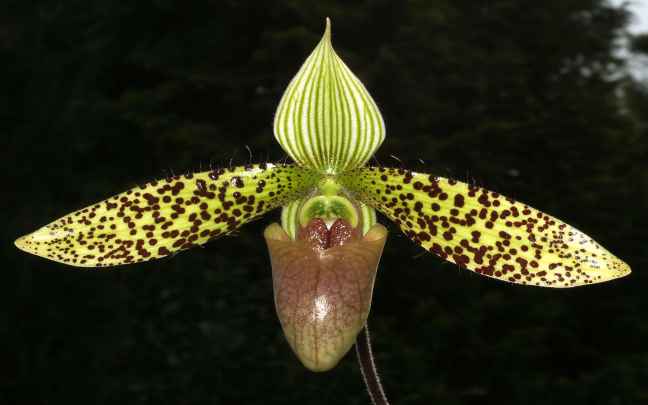Paphiopedilum is a genus of orchids commonly known as venus slipper orchids, currently comprising 96 cataloged species, most of which are classified as terrestrial, that is, they are found in the soil in their natural habitat.
Today, they are highly admired by cultivators worldwide, and cultivating them has several advantages:
- Easy to grow.
- Can be planted in the ground.
- Boast beautiful and long-lasting flowers.
Keep reading this article to discover the quirks, characteristics, and, especially, how to care for the venus slipper orchid.
Learn How to Achieve Super Blooms on Your Orchids
🛑 If you love orchids and you're tired of not being able to make them bloom...
Then, know that thousands of beginner growers are achieving beautiful flowers on their orchids by following this method.
Click the button below to have beautiful orchids with show-worthy flowers every year. ⤵
How to Care

To care for the slipper orchid, follow these 7 steps:
- Plant it in pots or in the ground.
- Choose substrates with good water retention.
- Water before the substrate dries out.
- Fertilize once a month with chemical fertilizer.
- Repot every 2 years.
- Maintain a temperature between 13°C and 24°C (55°F and 75°F).
- Provide good lighting and moderate humidity.
By following these steps, your Paphiopedilum will bloom every year.
Below, we’ll delve into each of these steps.
1 – What Substrates to Use
Even though they are terrestrial, Paphiopedilum orchids should not be planted in regular soil. Planting them in common soil can hinder root growth and respiration, making cultivation troublesome.
In nature, terrestrial orchids:
- Receive numerous nutrients from trees and dead animals.
- Have a good amount of water most of the time.
Therefore, when choosing the soil for your orchid, make sure it retains water well but doesn’t become waterlogged.
As venus slipper orchids lack pseudobulbs and stems, they cannot store water. Hence, the substrate should remain moist but not waterlogged.
Some of the most recommended soil for growing Paphiopedilum are:
- Sphagnum moss
- Perlite
- Coconut fiber
- Fine pine bark
- Bark mixes
You can also mix these substrates together.
In addition, if you plant your slipper orchid in a pot, replace the substrate every 2 or 3 years on average. Old substrates can suffocate the orchid’s roots. When the substrate compresses, it inhibits root growth and respiration.
2 – How to Water
While with most orchids, you have to be cautious about excessive watering, venus slipper orchids, in this case, are different. One of the most important considerations is lack of water. These orchids cannot store water, so avoid dehydrating them.
Here are some tips:
- Watering should be increased during hot weather, as water evaporation is higher.
- Never let the substrates dry out completely.
- Also, avoid waterlogging the roots.
- When watering, do so in the morning, using warm water.
- Use rainwater or distilled water.
- Avoid getting water on the leaves, as this can lead to fungal infections.
Follow these guidelines, and your slipper orchid will thrive.
3 – How to Fertilize
Slipper orchids mostly do not require a large amount of fertilizer. This is because they have slower growth, which means they use fewer nutrients. Therefore, during the vegetative period, fertilize once a month.
The vegetative period is the time between germination and flowering, during which the plant grows and strengthens through photosynthesis, accumulating resources that will be crucial in the following phase.
Source: CANNA BRASIL
One month before flowering, fertilize your orchid once a week.
The suitable foliar fertilizers are:
- NPK 10-10-10
- NPK 20-20-20
- NPK 30-10-10 (only if cultivated in bark, as bark decomposes and requires more nitrogen)
When applying, remember to spray both on the leaves and on the substrate. But be cautious about the time; preferably, fertilize in the early morning (before 9 a.m.).
Follow the instructions on your fertilizer label and dilute the fertilizer in the recommended proportion before applying it to the plant.
Sunlight combined with fertilizer can burn the leaves and roots.
4 – How to Plant and Repot
To plant Paphiopedilum, follow these steps:
Choose where to plant it (pot or ground).
- For planting in the ground, choose a location that meets your orchid’s lighting and ventilation needs. Also, ensure the area is clean to avoid future pest or disease problems.
- The best pot for planting or repotting your Paphiopedilum is a transparent plastic pot because it retains more moisture. Additionally, ensure the pot has drainage holes.
For ground planting:
- Plant your orchid normally but remember to use plenty of organic material.
For pot planting:
- Fill the pot halfway with soil rich in organic matter and substrate.
- Place your orchid in the pot (use a pot with drainage holes to prevent root rot).
- Finish filling the pot with organic soil and substrate.
- Add castor cake (optional).
Repotting
For Paphiopedilums, repotting occurs approximately every 2 years. However, if the plant is still very young, repotting can be done every year.
Repotting is necessary for three reasons:
- Old substrates: You’ll notice this when they become waterlogged or no longer drain water.
- Plant too large: Just check if your plant is not awkward in its pot.
- Plant multiplication: When the orchid is older.
Remember that repotting should be done after flowering (during the growth period) so that the orchid doesn’t expend too much energy.
5 – Ideal Temperature
The slipper orchid is quite hardy regarding temperatures, enduring extreme conditions for a short period (from 5ºC to 35ºC – 41°F to 95°F).
However, be cautious, as these temperatures can hinder its flowering and growth.
Ideal conditions are around 18ºC to 24ºC (64,5°F to 75°F) during the day and 13ºC to 16ºC (55,5°F to 61°F) at night.
This drop in temperature at night is crucial for optimal blooming and growth. If you live in a place with temperatures higher than these, increase humidity or ventilation in the environment.
6 – Lighting
The Paphiopedilum thrives in well-lit areas. In its natural habitat, it dwells in locations with excellent illumination. Good lighting not only contributes to your orchid’s health but also stimulates flowering.
However, beware! Just because the Paphiopedilum enjoys well-lit spaces doesn’t mean it should receive direct sunlight. Place it where it gets plenty of indirect sunlight, avoiding direct exposure.
Direct sunlight can scorch its leaves.
To determine if the lighting is excessive or insufficient, follow these tips or refer to the article “Stains on Orchid Leaves”.
Check your orchid’s leaf color.
- If the leaves are very dark green, it needs more light.
- If the leaves have a yellowish tone, it’s receiving too much light.
The ideal shade is a medium green.
Paphiopedilum orchids can also be grown under artificial lights.
Do You Want to Learn How To Keep Your Orchids Healthy And Ready to Bloom Every Year?
So, I prepared a complete guide, step by step and illustrated, that will show you:
• The secrets to getting beautiful flowers every year
• How to fight and identify pests and diseases on your orchids
• THE MAGIC SUBSTANCE for orchids and how to use it
• And much, much more.
The great news is that the manual is now available at a super discount!!
But beware, it's only for the first buyers.
Click on MORE INFORMATION below and discover the secrets to show-worthy flowers. 👇
7 – Proper Humidity
As mentioned earlier, humidity can help your plant endure higher temperatures. But what’s the ideal humidity for Paphiopedilum orchids?
This can vary slightly from species to species, but most Paphiopedilum orchids prefer humidity levels between 40% and 60%.
If you need to increase humidity around your plant, there’s a simple trick: place a shallow tray with some stones filled with water near your orchids. Never position them under the pot, as this could lead to root rot.
Also, check out:
Curiosities and Characteristics
Being originally from the Asian continent, they live in different locations, ranging from:
- China
- Himalayas
- Philippines
- Laos
- Among other countries.
Thanks to its unusual labellum, this orchid received the name paphiopedilum.
This because:
- Paphos, is the name of a city in Cyprus
- Pedilum means slipper (because its lip looks like a slipper).
Furthermore, it was also thanks to the lip that the Venus slipper orchid received its popular name.
And also several others such as tamanquinho orchid.
As there are still no ways to clone a paphiopedilum, this genus is not as common as, for example, moth orchids (phalaenopsis).
Furthermore, its multiplication by seed is also difficult, which greatly limits this orchid.
What Paphiopedilum Flowers Look Like


Slipper orchids bloom once a year, usually in winter or on colder days. Its flowers can last from 6 to 8 weeks, and it is possible to find brown, green, red or even yellow flowers depending on the species.
Furthermore, they can have uni-floral stems and other multi-floral stems.
How Long Does It Take to Flower?
If you bought a slipper orchid seedling or grew it from seeds (which is very difficult, but possible) and it is taking a long time to bloom, don’t be alarmed.
Paphiopedilum take an average of 3 to 4 years to give their first flowering.
Cypripedium Orchids
Apart from Paphiopedilum, there’s another genus of terrestrial orchids known as slipper orchids: Cypripedium.
Composed of around 57 species, this genus is little known in tropical countries, mainly because it prefers cold environments.
Its flowers closely resemble those of Paphiopedilum, earning it the nickname “slipper orchid”.
However, they are very different orchids.
Cypripedium is primarily found in Asia, where it has been used in traditional medicine. Most of its species are endangered, making them increasingly rare.
Famous Species
Among the 96 species of Paphiopedilum that have been discovered in nature, there are some that stand out among orchid growers, the main ones being:
- Paphiopedilum insigne: is a species native to Southeast Asia. Its flowers are large and vibrant and last between 20 and 30 days on average.
- Paphiopedilum delenatii: small orchid found in Asia. Its flowering lasts about 30 days.
- Paphiopedilum rothschildianum, also known as Rothschild’s slipper orchid, is a species native to Asia. It has large, colorful flowers, which can last up to 8 weeks. This is an orchid considered rare.
In addition to these species mentioned, there are some others that are also prominent among growers:
- Paphiopedilum leeanum
- Paphiopedilum sukhakulii
- Paphiopedilum victoria-reginae
- Paphiopedilum sanderianum
- Paphiopedilum barbatum
- Paphiopedilum stonei
- Paphiopedilum philippinense
- Paphiopedilum hirsutissimum
- Paphiopedilum delenatii
If you want to continue learning about orchids, explore our complete cultivation manual:
Conclusion
That concludes the comprehensive guide on how to care for slipper orchids. Now you have the knowledge to cultivate these orchids successfully.
Do you have any questions or want to share how you’re caring for your Paphiopedilum? Feel free to leave a comment.





















